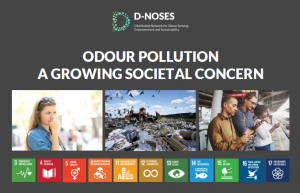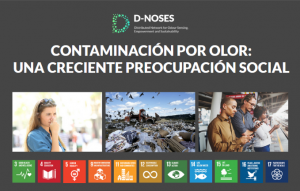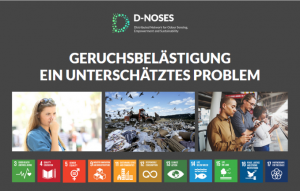Odour Governance done right - read our Policy Brief
D-NOSES aims to introduce a more balanced, bottom-up approach to odour governance using Citizen Science as a way to bridge existing regulatory gaps. Local, regional, national and even international authorities have an important role to play in this effort, paving the way for citizens to take responsibility for their own environment. One of the instruments to help with this is a our Policy Brief, which outlines the problem and explains how D-NOSES can be applied to resolve it.
Read on below to find out more about the Policy Brief and how it can help improve odour governance. Or you can jump into action and click to download the policy brief on the right, made available in several different languages.
German DE | Italian IT | Spanish SP | French FR | Portuguese PT | Bulgarian BG | English EN | Greek GR
Odour pollution is a growing problem …
As cities continue to grow, the space between industry, agricultural facilities, and residential areas is decreasing. This exposes an increasing number of citizens to recurring odour pollution. In fact, odour pollution is the second leading reason for environmental complaints in Europe (Dunod 2005). Despite this, regulation is insufficient at best and, in many European areas, environmental regulations ignore odour issues completely.
But why?
Odour pollution is not a recent issue. Many publications in the late 1990’s and early 2000’s have dealt with odour issues and proposed new mathematical models to calculate the dispersion of emissions from the source. This should have helped to protect communities at the planning and environmental permit stage. Considering the number of odour complaints, this has not had the desired effect. While there may be many reasons for this, we believe one of the main ones is the fact that most of the methods in use today are still focused on odour levels and do not measure impact on people directly.
More recently, scientific reviews of existing odour regulations have alerted to the lack of a common definition and approach. Even with this evidence, change is slow or non-existent. The lack of standardised regulations and, in some cases, complete lack of oversight is mainly due to three factors:
- Odours are difficult to measure
- The implementation of solutions can be costly
- Industries often oppose changes in regulation
What can be done?
D-NOSES aims to provide an inclusive approach to tackling odour issues. It will address the three issues mentioned above by:
- Using the most sensitive odour sensors, i.e. the human nose, to gather data on odours but also directly measuring impact
- Introducing a cost-effective method to measure and correlate odour incidents with industrial or agricultural activities, in order to pinpoint the actual odour sources
- Facilitating an effective and targeted dialogue with all stakeholders involved
And what if we don’t?
While the status quo is due to the persistent belief that odour are a mere nuisance, there is growing evidence that it can have significant effects. In fact, some studies have shown that persistent exposure to bad odours can affect people’s health, causing coughs, headaches and nausea among other symptoms. This, in combination with the potential social and economic effects, paints a grim picture of the future of affected communities and will undoubtedly keep on causing conflicts, as it already does in many areas. As cities continue to grow, the likelihood is that encroachment (the expansion of urban and industrial areas towards each other) will generate an increasing number of conflict areas.
Somebody should do something …!
But who? At D-NOSES we don’t want to prescribe a one-size-fits-all solution for the many possible problems that occur. Instead, we believe that each problem should have its own solution. What is needed is not necessarily new burdensome regulations, but a framework that allows citizens and all stakeholders to work together towards a balanced solution.
How to start …
The complexity of the odour pollution question can make it difficult for stakeholders to fully grasp the issues. To support local decision-makers, emitting industries, and affected citizens in understanding the key facts, D-NOSES has published a policy brief entitled “Odour pollution – A growing societal concern”. The aim is to give readers a short, four-page introduction to the issues and explain the practical value of the proposed D-NOSES solution. This should raise awareness of odour pollution and provide all stakeholders with the necessary background knowledge to think about how they can engage in productive dialogues and effective co-created solutions.






